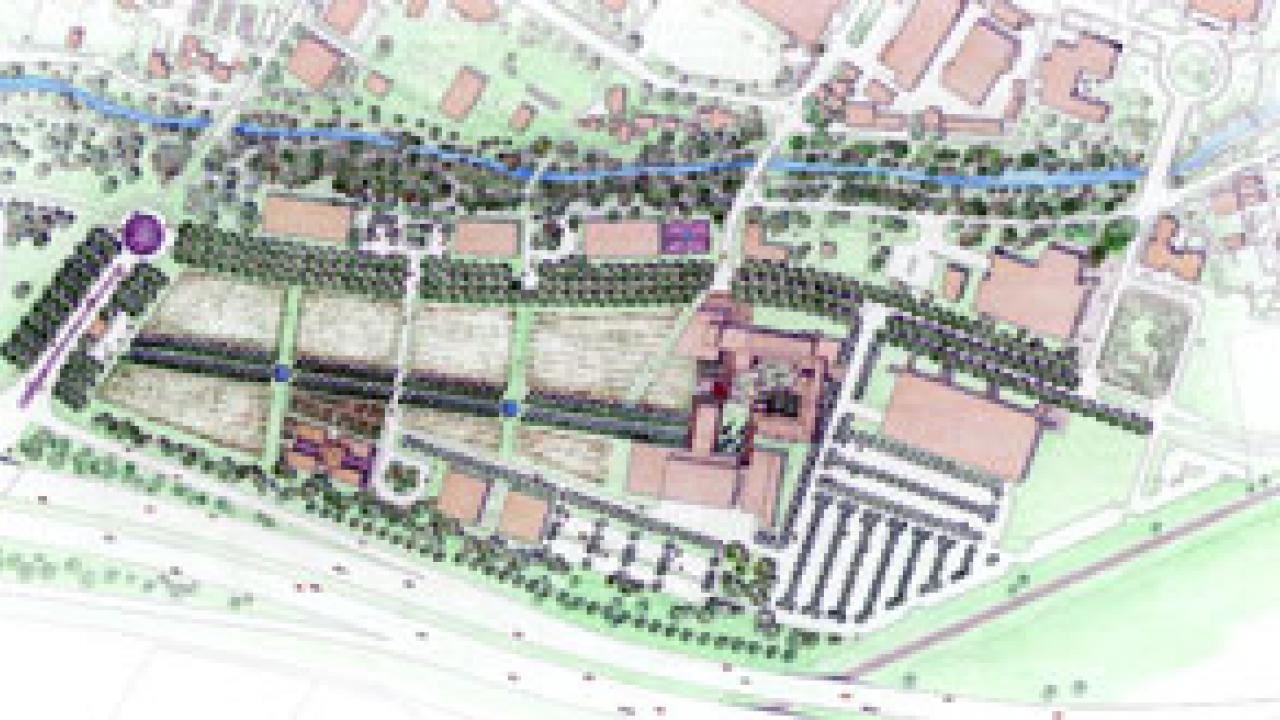One sway at a time, UC Davis' new front door is swinging open.
The new South Entry zone for academic buildings at the I-80/Old Davis Road entry to campus is one of the key elements in the campus' 2003 Long Range Development Plan. It's been more than a decade in the works, and the next few years will witness more dramatic progress toward establishing UC Davis' front door to the region.
"The fundamental idea is to connect people with the campus in a much more direct fashion," said Bob Segar, assistant vice chancellor for campus planning. "We are intentionally redesigning the South Entry zone to embrace the public and the greater region that we serve through our research, teaching and outreach programs and activities."
The new South Entry will expand on the themes of the current design. One spectacular touch involves plans for research vineyards, courtyards, walkways and fields to stretch westward from the planned Robert Mondavi Institute for Wine and Food Science.
"The surrounding landscape in the South Entry District project will reflect the heritage of the campus and the presence of the nearby Robert and Margrit Mondavi Center for the Performing Arts," said Segar. "The new institute will serve as the bridge between agriculture and the arts, both programmatically and physically."
This "opening up" theme also reflects the campus's desire to bring South Entry visitors more directly into the core campus area, Segar said.
Currently, freeway traffic arriving onto campus near the South Entry has no direct route to the center of campus. Instead, traffic must flow to the right for a considerable distance before routes are available into the interior of campus.
This will change under the new strategy; a vehicular bridge over Putah Creek will bring freeway-exiting traffic straight onto La Rue Road near Meyer Hall. Plans call for building a roundabout with generous landscaping and signage welcoming visitors to the university.
Academic building sites for academic use are envisioned along the southern portion of the Arboretum. In another project, the campus is designing a research park at the Old Davis Road interchange at I-80 for partnerships between UC Davis and private, public and nonprofit organizations.
Upcoming projects for the new South Entry zone include the Mondavi Institute, a new administrative and classroom building for the Graduate School of Management, a hotel and conference center, a visual arts museum and a realignment of Old Davis Road, among others.
While some pieces of the new South Entry puzzle have already been inserted -- for example, the Mondavi Center and the Buehler Alumni and Visitors Center -- it may take a few years before the entire landscape comes together as visualized, Segar said.
Everything's moving forward, especially the big items. On Feb. 18, the UC Board of Regents approved the designs for the Robert Mondavi Institute. And, back in November the regents approved the general concept for the new South Entry zone development along with UC Davis' LRDP.
From functionality -- like more direct routes to campus -- to the incorporation of campus heritage with the agricultural landscape sweeping vistas -- the new South Entry is one of the more exciting aspects of the LRDP, Segar said.
On a clear day one will be able to stand in the Mondavi Institute's courtyard and look westward across the teaching vineyards and see the coastal ranges.
The $78 million Mondavi Institute will provide teaching and research facilities for the departments of viticulture and enology, and food science and technology. One key issue is that $32 million of its funding is dependent on voters approving Proposition 55 on March 2. That bond measure includes funding for about $113 million in projects at UC Davis, including the institute.
In the next few years, UC Davis plans to build an on-campus conference center and hotel at a site across from the Mondavi Center. The new facility will provide a state-of-the-art venue for regional, national and international academic conferences, enhancing UC Davis' visibility as a pre-eminent research and learning institution.
The Long Range Development Plan builds on campus traditions by providing alternative transportation, affordable housing, generous open spaces and preservation of agricultural areas on and off the core campus.
The LRDP will allow UC Davis to meet its obligations to the state to accommodate more students, anticipating an average on-campus student population of 30,000 and a total enrollment of 32,000 by 2015, as well as an increase in faculty and staff to support those students. This year, UC Davis expects an annual average of 27,500 students on its main campus and a total enrollment of 30,200.
The LRDP and accompanying documents are available at http://www.ormp.ucdavis.edu/environreview/lrdp.html.
